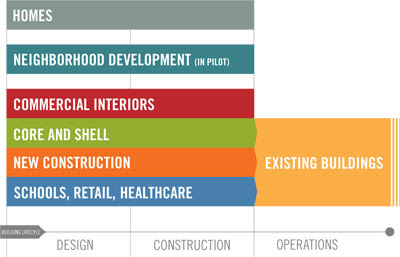The U.S. Green Building Council (USGBC) currently has over nine LEED rating systems covering commercial and residential buildings, interiors, and exteriors, all the way up to entire neighborhoods, and several more systems are on the way. Even as LEED continues to proliferate, however, a movement continues among USGBC leadership to make it more unified, scientifically rigorous, and regionally appropriate. First discussed at the Greenbuild Conference in 2006, USGBC announced at Greenbuild 2007 that it would continue to move LEED toward a “bookshelf” of credits while incorporating both structural and technical changes. At the same time, weighting of environmental priorities, life-cycle assessment (LCA), and regional credits all promise to affect LEED and its point structure.

Whereas the original rating system applied only to new construction and was drafted with commercial office towers in mind, LEED has grown so much in popularity and use that new rating systems have been specifically created for different kinds of buildings. There are now LEED standards for existing buildings (focusing on energy-efficient maintenance and nontoxic operations); core and shell (exterior walls and windows, electrical and plumbing systems); commercial interiors (doors and walls, lighting and plumbing fixtures); homes (only for new construction in its pilot phase) and neighborhood developments (for example, a redevelopment zone).
Like any young industry, LEED is evolving rapidly. Lessons learned from pilot projects are used to improve the next version of the standard. Work is now under way on the 3.0 version, which will attempt to assess the environmental impact of a product or material over its complete lifecycle. It’s a difficult and important task, and whatever emerges is guaranteed to generate controversy. But once again, by providing a framework, language, and measurement system for lifecycle analysis, LEED will fuel conversations and spur market growth.

No comments:
Post a Comment